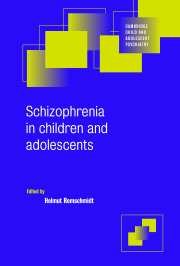Crossref Citations
This Book has been
cited by the following publications. This list is generated based on data provided by Crossref.
Remschmidt, Helmut
Hennighausen, K.
Heiset, P.
Clement, W.
and
Schulz, E.
2000.
Atypical neuroleptics in child and adolescent psychiatry.
European Child & Adolescent Psychiatry,
Vol. 9,
Issue. S1,
p.
S9.
Remschmidt, H.
2004.
Therapie der Krankheiten im Kindes- und Jugendalter.
p.
1829.
Remschmidt, H.
2004.
Therapie der Krankheiten im Kindes- und Jugendalter.
p.
1764.
Remschmidt, H.
2004.
Therapie der Krankheiten im Kindes- und Jugendalter.
p.
1778.
Remschmidt, H.
2004.
Therapie der Krankheiten im Kindes- und Jugendalter.
p.
1821.
Remschmidt, H.
2004.
Therapie der Krankheiten im Kindes- und Jugendalter.
p.
1812.
Remschmidt, H.
2004.
Therapie der Krankheiten im Kindes- und Jugendalter.
p.
1825.
Remschmidt, H.
2004.
Therapie der Krankheiten im Kindes- und Jugendalter.
p.
1803.
Remschmidt, H.
2004.
Therapie der Krankheiten im Kindes- und Jugendalter.
p.
1790.
Remschmidt, H.
2004.
Therapie der Krankheiten im Kindes- und Jugendalter.
p.
1739.
Remschmidt, H.
2004.
Therapie der Krankheiten im Kindes- und Jugendalter.
p.
1760.
Remschmidt, H.
2007.
Therapie der Krankheiten im Kindes- und Jugendalter.
p.
1878.
Herpertz-Dahlmann, B.
and
Herpertz, S.
2010.
Kinder-, Jugend- und Erwachsenenpsychiatrie.
Der Nervenarzt,
Vol. 81,
Issue. 11,
p.
1298.





